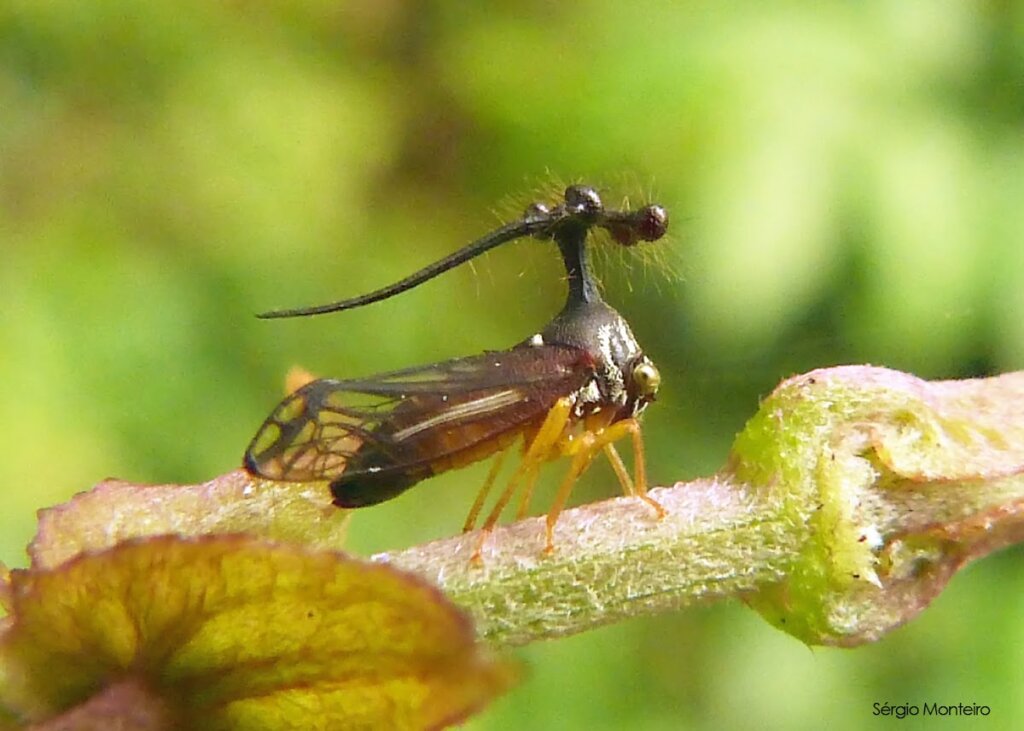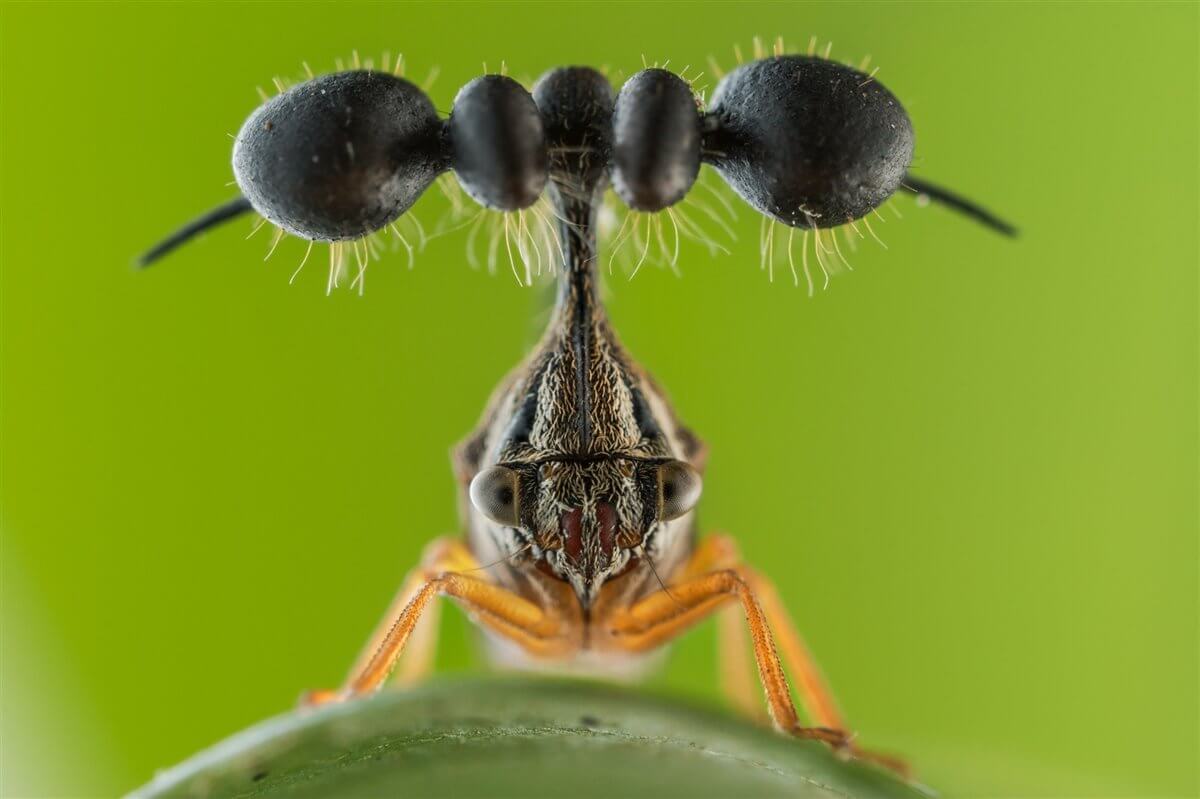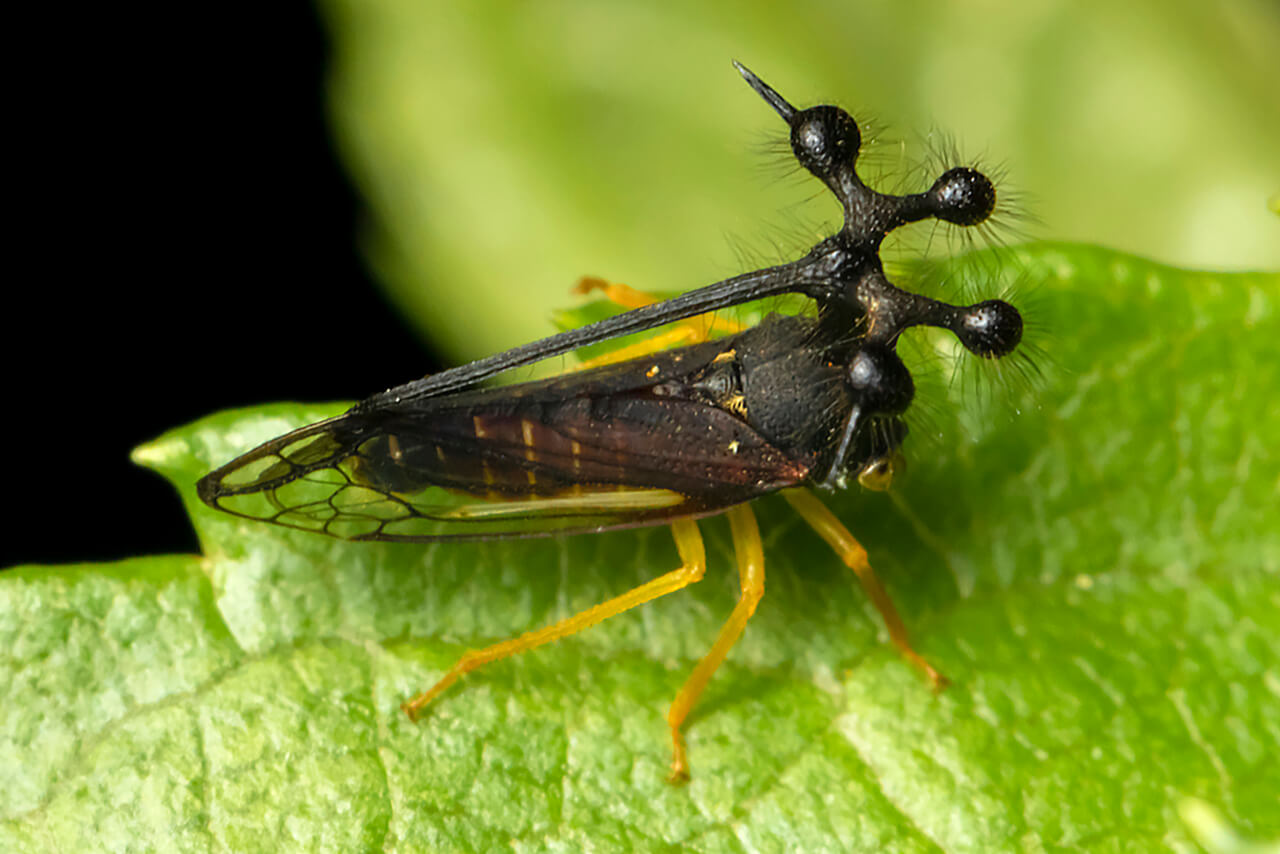Brazilian Treehopper: The Strangest Insect You'll Ever See

The Membacidae are a family of winged insects with a cosmopolitan distribution that stand out for their incredible shapes and striking colors. However, of the nearly 3300 species that have been compiled, the Brazilian treehopper is considered the strangest of all.
If you want to know all about the characteristics, behaviors, feeding, and habitat of this amazing specimen, don’t miss the information we’ll share with you in the following article.
Physical characteristics
This small insect, whose scientific name is Bocydium globulare, barely reaches 7.5 millimeters (0.3 inches) in length in its adult stage. It has an elongated triangle-shaped body and a flattened head with two large yellow eyes.
It’s equipped with 6 long limbs and 2 large wings, which – like all neopterans – can fold vertically when at rest. Although these characteristics are very common among insects, there’s one feature that makes it stand out from the rest: the exotic protuberance on its head.
The “horn“ of the Brazilian treehopper

The pronotum (anterior part of the thorax) of the Brazilian treehopper has acquired a rather peculiar and extravagant shape. It’s a three-dimensional structure that resembles the blades of a helicopter.
It consists of vertical elongation and a series of 5 branches that end in circular appendages full of hairs. Four of them are short and arranged in such a way that they form the apex of a trapezoid. The fifth, which is long and pronounced, extends to the final portion of its abdomen. Although biologists and entomologists have searched for the meaning of this phenomenon over the years,
there is still no consensus on the function of this structure in the insect’s biology. On the one hand, as suggested by a publication in the journal Nature suggests, the appearance of the pronotum may help deter predators. This is because its shape may be intimidating for birds or amphibians that intend to eat it.
On the other hand, according to a paper published at the IV Colombian Congress of Zoology, this protuberance would act as a mimicry tool, by keeping some similarity with some plant species.
In the absence of evidence to support these hypotheses, the Aragonese Entomological Society has proposed that the pronotum may be the product of an evolutionary occurrence.
This means that the genes involved in its development have nothing to do with survival. On the contrary, they’re merely an ornamental ornament that serves no function.
However, recent data, published in the journal Proceedings of The Royal Society, suggests that the regulation of protein synthesis and the genes involved in wing growth are of particular interest for future research into the meaning of this peculiar evolutionary innovation.
Where does the Brazilian treehopper live?
The Brazilian treehopper is native to the southern hemisphere of the American continent. It’s found in the Amazon rainforests of countries such as Brazil, Peru, Suriname, and French Guiana.
It has a preference for humid forests with a lot of vegetation, especially those in which we can find the species Tibouchina urvilleana.
Diet
Like its congeners, this insect is folivorous. It feeds on the sap found in the leaves of different plants, with a special predilection for above-mentioned plant.
It has a mouthpart composed of two sharp tubes. One for piercing the plant and the other for sucking sap from the phloem. It also has an accessory anal tube to remove excess food from its body. This residue is known as “honeydew”.
Reproductive behavior

Unlike other insects, females of the family Membracidae are characterized by being very good mothers. Initially, when it’s time for oviposition, they secrete a whitish substance to fix the eggs to the stems or leaves of plants. Once they remain there, they coat them again with this substance to create a hard amalgam that prevents them from being eaten by any predator.
Furthermore, according to an article shared in the journal Systematic Biology, female Brazilian treehoppers actively defend their offspring. They do this by perching on their eggs until they hatch, while flapping their wings and limbs to repel any approaching threats.
Social behavior
In some species of the Membracidae family, a very interesting natural phenomenon occurs: mutualistic relationships with other insects.
For example, according to a study reported in the journal PLoS One, the Aster treehopper allows ants to feed on its “honeydew” in exchange for protection from predators.
Similarly, according to the same paper, females have a preference for laying their eggs near ant colonies. This action has the objective of ensuring a higher survival rate of their offspring, because they count on the defense of arthropods.
“Ants take care of membacids in any of their juvenile life stages (eggs, nymphs), being more common the interaction with nymphs. The reduction in nymph predation rates is a result of ant protection rather than parental care.”
-Castillo Montoya, María Fernanda (2016)- (click on “documento” on the left hand side to see the article in English)
Although the Brazilian treehopper is characterized as a solitary animal, it’s suggested that it could adopt this particular behavior in its natural habitat.
In addition, these insects communicate through subtle vibrations, which are transmitted through plants. Thanks to this interlocution mechanism, the treehoppers can warn of a threat, attract mates, or indicate a good place to feed.
A fascinating and mysterious animal
The world was first introduced to the Brazilian treehopper during an exhibition by the German sculptor Alfred Keller. The astonished spectators thought they were viewing a piece created by the artist’s imagination!
Although many features related to its biology are known, the reason why its pronotum acquired such a particular shape is still unknown to science. Future studies will be necessary to clearly understand the dynamics involved in such incredible animals.
All cited sources were thoroughly reviewed by our team to ensure their quality, reliability, currency, and validity. The bibliography of this article was considered reliable and of academic or scientific accuracy.
- Álvarez, P. (2000). Un caprichoso estallido evolutivo: Los Membrácidos. Bol. S.E.A, (27), 93-98. http://sea-entomologia.org/PDF/BOLETIN_27/B27-038-093.pdf
- Bocydium globulare. (s.f.). Enciclopedia de animales. Consultado el 28 de mayo 2023. https://enciclopediadeanimales.com/bocydium-globulare/
- Castillo Montoya, M. F. (2016). The role of ants in membracidae parental care. Pontificia Universidad Javeriana. https://repository.javeriana.edu.co/handle/10554/41162#:~:text=membr%C3%A1cido%20y%20viceversa.-,Las%20hormigas%20cuidan%20a%20los%20membracidos%20en%20cualquiera%20de%20sus,no%20de%20la%20atenci%C3%B3n%20parental.
- Flórez–V, Camilo & Cardona-Duque, Juliana. (2014). Contribución a la taxonomía de la familia Membracidae (Hemiptera: Auchenorrhyncha) en Colombia. https://www.researchgate.net/publication/350190065_Contribucion_a_la_taxonomia_de_la_familia_Membracidae_Hemiptera_Auchenorrhyncha_en_Colombia
- Jocson, D. M. I., Smeester, M. E., Leith, N. T., Macchiano, A., & Fowler-Finn, K. D. (2019). Temperature coupling of mate attraction signals and female mate preferences in four populations of Enchenopa treehopper (Hemiptera: Membracidae). Journal of Evolutionary Biology, 32(10), 1046–1056. https://onlinelibrary.wiley.com/doi/10.1111/jeb.13506
- Kemp, M. (2010). Sculpture: Terrible wonder. Nature, 468(506-507). https://www.nature.com/articles/468506a
- Kudla, A. M., Miranda, X., & Nijhout, H. F. (2022). The roles of growth regulation and appendage patterning genes in the morphogenesis of treehopper pronota. Proceedings. Biological sciences, 289(1976), 20212682. https://www.ncbi.nlm.nih.gov/pmc/articles/PMC9174728/
- Lin, C. P., Danforth, B. N., & Wood, T. K. (2004). Molecular phylogenetics and evolution of maternal care in Membracine treehoppers. Systematic biology, 53(3), 400–421. https://academic.oup.com/sysbio/article/53/3/400/2842860?login=false
- Morales, M. A., & Zink, A. G. (2017). Mechanisms of aggregation in an ant-tended treehopper: Attraction to mutualists is balanced by conspecific competition. PloS one, 12(7), e0181429. https://www.ncbi.nlm.nih.gov/pmc/articles/PMC5521790/
- Ritcher, L. (2017). Membracidae colombianae. Revisión de las especies colombianas del género Membracis. Revista de la Academia Colombiana de Ciencias Exactas, Físicas y Naturales, 41, 22-246. https://raccefyn.co/index.php/raccefyn/article/view/588
